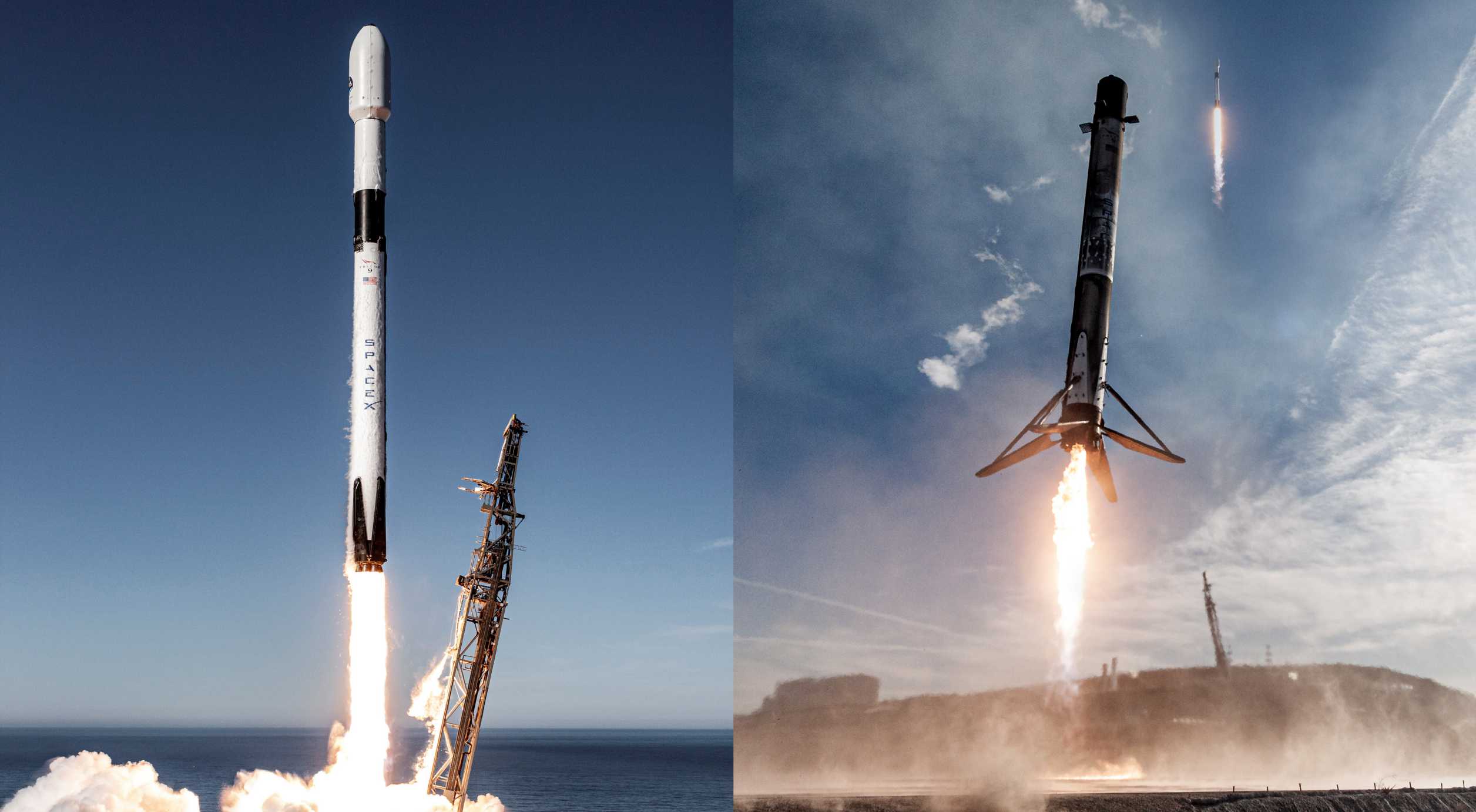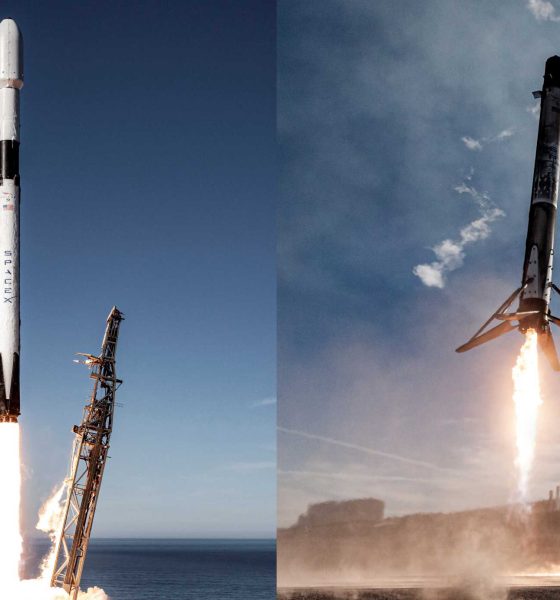

News
SpaceX wins Sentinel 6B radar satellite launch contract
SpaceX has won a contract to launch the joint US-European Sentinel 6B radar satellite as early as November 2025.
Five years ago, NASA also chose SpaceX to launch Sentinel 6A, the first of two identical satellites designed to use radar altimeters to determine global sea levels more accurately than ever before. In October 2017, just half a year after SpaceX’s first Falcon 9 rocket booster reuse and well before the cost savings that followed were fully factored in, NASA awarded SpaceX $94 million to launch the 1.1-ton (~2500 lb) to a relatively low 1300-kilometer (~810 mi) orbit.
Five years and two months later, NASA has awarded SpaceX $97 million to launch a virtually identical satellite to the same orbit, from the same launch pad, with the same rocket. SpaceX, however, is far from the same company it was in 2017, and has effectively mastered Falcon booster and payload fairing reuse in the half-decade since.
The update that's rolling out to the fleet makes full use of the front and rear steering travel to minimize turning circle. In this case a reduction of 1.6 feet just over the air— Wes (@wmorrill3) April 16, 2024
Beginning in March 2017, SpaceX has reused Falcon boosters on 130 launches, including sensitive US military missions and even NASA astronaut launches. SpaceX has launched almost 70 internal Starlink missions (carrying more than 3600 SpaceX-built satellites) without bankrupting the company. CEO Elon Musk has stated that the marginal cost of a barebones Falcon 9 launch is just $15 million, while another executive once pegged the total cost of a Falcon 9 launch with flight-proven hardware at $28 million.
Perhaps most significantly, SpaceX won a contract in 2019 to launch NASA’s tiny IXPE X-ray telescope on Falcon 9 for only $50 million. SpaceX completed the mission in December 2021, launching the 330-kilogram (~730 lb) spacecraft into a roughly 600-kilometer (~370 mi) orbit. IXPE was initially expected to launch on Aerojet Rocketdyne’s troubled air-launched Pegasus XL rocket, which last launched a small NASA spacecraft for about $55 million.
Writ large, that may be the best explanation for why SpaceX and its executives – both of which have relentlessly reiterated that the company’s purpose is to radically reduce the cost of orbital launches – don’t feel pressure to translate those major cost decreases into major price cuts. Put simply, despite the fact that SpaceX has openly discussed its intentions for more than a decade, there isn’t a rocket on Earth that can beat Falcon 9’s combination of performance, cadence, reliability, and affordability.
In lieu of even a hint of competitive pressure from the rest of the industry, particularly for contracts limited to US industry, SpaceX appears to have decided that the profits from charging as much as possible outweigh the cynicism those actions could convey. To SpaceX’s credit, the reality is also more gray than some of the limited data might imply. Over the last three years, SpaceX’s prices for smallsat rideshare customers have repeatedly decreased and become more flexible. Additionally, accounting for five years of inflation, SpaceX’s $94 million Sentinel 6A contract would be worth about $114 million today, meaning that its $97 million Sentinel 6B launch contract technically represents a modest 15% discount.
It’s also likely that SpaceX’s main competitors, ULA and Arianespace, would have charged tens of millions of dollars more to launch Sentinel 6A or 6B on their current or next-generation rockets. But their existing rockets have no spare capacity for new contracts and their new Vulcan and Ariane 6 rockets have yet to fly, leaving SpaceX without any real competition.
For better or worse, it appears that Falcon 9 rideshare customers and SpaceX’s own Starlink constellation are the only major beneficiaries of Falcon 9’s extraordinary newfound affordability. With potential competitors like Rocket Lab’s Neutron, Relativity’s Terran-R, Blue Origin’s New Glenn, and ULA’s semi-reusable Vulcan variant all years from market entrance, that’s unlikely to change until the mid-to-late 2020s. Until then, even though SpaceX’s pricing is unlikely to revolutionize others’ access to space, Falcon 9 will remain an exceptionally affordable and available option for all launch customers – including NASA and ESA.

News
Tesla FSD fleet is nearing 7 billion total miles, including 2.5 billion city miles
As can be seen on Tesla’s official FSD webpage, vehicles equipped with the system have now navigated over 6.99 billion miles.

Tesla’s Full Self-Driving (Supervised) fleet is closing in on almost 7 billion total miles driven, as per data posted by the company on its official FSD webpage.
These figures hint at the massive scale of data fueling Tesla’s rapid FSD improvements, which have been quite notable as of late.
FSD mileage milestones
As can be seen on Tesla’s official FSD webpage, vehicles equipped with the system have now navigated over 6.99 billion miles. Tesla owner and avid FSD tester Whole Mars Catalog also shared a screenshot indicating that from the nearly 7 billion miles traveled by the FSD fleet, more than 2.5 billion miles were driven inside cities.
City miles are particularly valuable for complex urban scenarios like unprotected turns, pedestrian interactions, and traffic lights. This is also the difference-maker for FSD, as only complex solutions, such as Waymo’s self-driving taxis, operate similarly on inner-city streets. And even then, incidents such as the San Francisco blackouts have proven challenging for sensor-rich vehicles like Waymos.
Tesla’s data edge
Tesla has a number of advantages in the autonomous vehicle sector, one of which is the size of its fleet and the number of vehicles training FSD on real-world roads. Tesla’s nearly 7 billion FSD miles then allow the company to roll out updates that make its vehicles behave like they are being driven by experienced drivers, even if they are operating on their own.
So notable are Tesla’s improvements to FSD that NVIDIA Director of Robotics Jim Fan, after experiencing FSD v14, noted that the system is the first AI that passes what he described as a “Physical Turing Test.”
“Despite knowing exactly how robot learning works, I still find it magical watching the steering wheel turn by itself. First it feels surreal, next it becomes routine. Then, like the smartphone, taking it away actively hurts. This is how humanity gets rewired and glued to god-like technologies,” Fan wrote in a post on X.
News
Tesla starts showing how FSD will change lives in Europe
Local officials tested the system on narrow country roads and were impressed by FSD’s smooth, human-like driving, with some calling the service a game-changer for everyday life in areas that are far from urban centers.

Tesla has launched Europe’s first public shuttle service using Full Self-Driving (Supervised) in the rural Eifelkreis Bitburg-Prüm region of Germany, demonstrating how the technology can restore independence and mobility for people who struggle with limited transport options.
Local officials tested the system on narrow country roads and were impressed by FSD’s smooth, human-like driving, with some calling the service a game-changer for everyday life in areas that are far from urban centers.
Officials see real impact on rural residents
Arzfeld Mayor Johannes Kuhl and District Administrator Andreas Kruppert personally tested the Tesla shuttle service. This allowed them to see just how well FSD navigated winding lanes and rural roads confidently. Kruppert said, “Autonomous driving sounds like science fiction to many, but we simply see here that it works totally well in rural regions too.” Kuhl, for his part, also noted that FSD “feels like a very experienced driver.”
The pilot complements the area’s “Citizen Bus” program, which provides on-demand rides for elderly residents who can no longer drive themselves. Tesla Europe shared a video of a demonstration of the service, highlighting how FSD gives people their freedom back, even in places where public transport is not as prevalent.
What the Ministry for Economic Affairs and Transport says
Rhineland-Palatinate’s Minister Daniela Schmitt supported the project, praising the collaboration that made this “first of its kind in Europe” possible. As per the ministry, the rural rollout for the service shows FSD’s potential beyond major cities, and it delivers tangible benefits like grocery runs, doctor visits, and social connections for isolated residents.
“Reliable and flexible mobility is especially vital in rural areas. With the launch of a shuttle service using self-driving vehicles (FSD supervised) by Tesla in the Eifelkreis Bitburg-Prüm, an innovative pilot project is now getting underway that complements local community bus services. It is the first project of its kind in Europe.
“The result is a real gain for rural mobility: greater accessibility, more flexibility and tangible benefits for everyday life. A strong signal for innovation, cooperation and future-oriented mobility beyond urban centers,” the ministry wrote in a LinkedIn post.
News
Tesla China quietly posts Robotaxi-related job listing
Tesla China is currently seeking a Low Voltage Electrical Engineer to work on circuit board design for the company’s autonomous vehicles.

Tesla has posted a new job listing in Shanghai explicitly tied to its Robotaxi program, fueling speculation that the company is preparing to launch its dedicated autonomous ride-hailing service in China.
As noted in the listing, Tesla China is currently seeking a Low Voltage Electrical Engineer to work on circuit board design for the company’s autonomous vehicles.
Robotaxi-specific role
The listing, which was shared on social media platform X by industry watcher @tslaming, suggested that Tesla China is looking to fill the role urgently. The job listing itself specifically mentions that the person hired for the role will be working on the Low Voltage Hardware team, which would design the circuit boards that would serve as the nervous system of the Robotaxi.
Key tasks for the role, as indicated in the job listing, include collaboration with PCB layout, firmware, mechanical, program management, and validation teams, among other responsibilities. The role is based in Shanghai.
China Robotaxi launch
China represents a massive potential market for robotaxis, with its dense urban centers and supportive policies in select cities. Tesla has limited permission to roll out FSD in the country, though despite this, its vehicles have been hailed as among the best in the market when it comes to autonomous features. So far, at least, it appears that China supports Tesla’s FSD and Robotaxi rollout.
This was hinted at in November, when Tesla brought the Cybercab to the 8th China International Import Expo (CIIE) in Shanghai, marking the first time that the autonomous two-seater was brought to the Asia-Pacific region. The vehicle, despite not having a release date in China, received a significant amount of interest among the event’s attendees.








